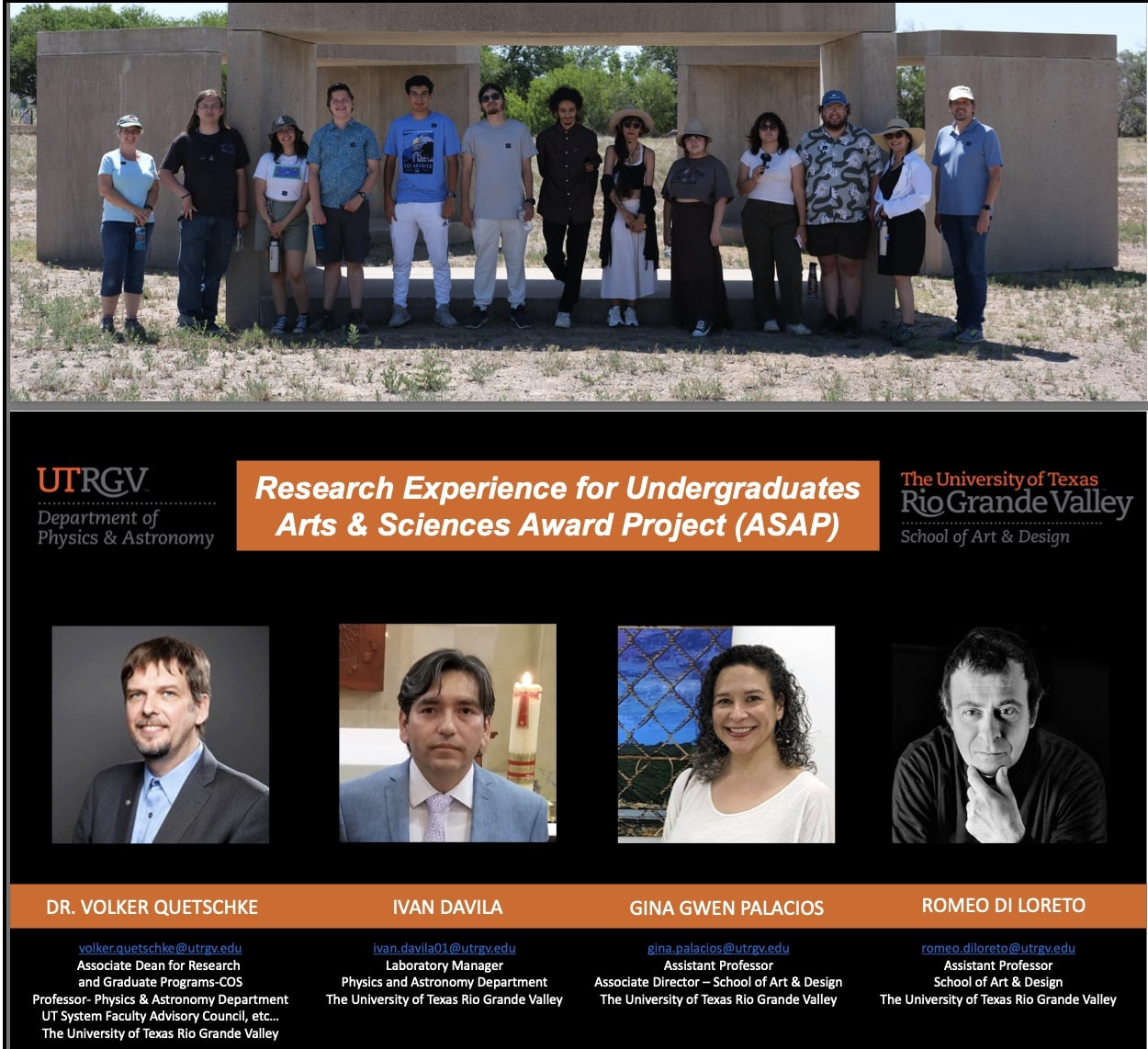Overview
Students and Teachers can choose a research experience from various areas related to the Department of Physics and Astronomy at UTRGV.
The program is funded through the National Science Foundation (NSF) award 1757830 "REU and RET Site in Physics at UTRGV" with Volker Quetschke as principal investigator.
Research Experience Areas
Title: Particle Swarm Optimization for Maximum Likelihood Estimation
Faculty Mentor: Dr. Soumya Mohanty
Particle Swarm Optimization (PSO) is a method for finding the global maximum of high dimensional functions that have multiple local optima. It is one among a diverse set of methods inspired by examples of optimization in biology. For example, Genetic Algorithm (GA) is inspired by Darwinian evolution, while Ant Colony Optimization (ACO) is modeled on the foraging behavior of ants. Since challenging optimization problems are ubiquitous in every field of science and engineering, methods like PSO, GA and ACO have made a significant and broad impact across a wide range of application areas. The same is true for gravitational wave (GW) data analysis, where the basic optimization problem is that of statistical regression— finding the signal model that best fits some given noisy data. In this project, students will learn about PSO and apply it to challenging current optimization problems in astronomical (including GW) data analysis. This project is quite feasible for undergraduate students having a good background in programming and it can lead to publishable results.
Title: Characterization of background noise in LIGO
Faculty Mentor: Dr. Soma Mukherjee
One of the major areas of research in LIGO is called Detector Characterization. This involves looking at and characterizing the real data coming out of the LIGO detectors, both in real time, and off-line. Noise analysis provides feedback to the experimentalists so that the instrument can be diagnosed for spurious behavior. This provides a great platform for under-graduate students to learn about both the detector physics and the data analysis techniques.
Students will work on developing and testing methods to detect correlation between time series from different detector channels. Specifically, students will learn about LIGO data, methods of storage and extraction of LIGO data, MATLAB as a data analysis tool, methods of statistical data analysis and methods of looking at glitches seen in the data to understand their possible origin in the detector sub-systems.
Title: Pulsar survey and timing observations
Faculty Mentors: Dr. Fredrick A. Jenet / Dr. Teviet Creighton
There are several research opportunities based on radio frequency technologies that ongoing at CARA. In astronomy and astrophysics, students will be able to operate several of the world’s largest radio telescopes including the Arecibo and Green Bank radio observatories. They can participate in sky surveys that are searching the Galaxy for exotic stars known as radio pulsars. Students will also be involved in analyzing the resulting data in order to determine the presence, or absence, of the tell-tale signature of these stars. New discoveries made by the students have the potential to be a part of the galactic scale gravitational wave observatory being developed by the NANOGrav collaboration. CARA scientists have also developed the Low Frequency All Sky Monitor (LoFASM), a network of small scale radio telescopes that are listening for transient radio bursts whose origin is still a mystery. Summer students will have the opportunity to use the LoFASM instrument to search for such signals and gain insight into low frequency radio technology.
CARA is also heavily involved in technology development associated with commercial space exploration, or NewSpace. Under the STARGATE program, CARA researchers are developing advanced radio transmitting and receiving systems using phased array technology. These new systems are being designed for small satellite communication platforms as well as spacecraft tracking during launch. RF based communication systems are also being developed to move data collected by a large number of sensor platforms using mesh style networks. REU students can have the opportunity to work on research related to these and other RF based technologies being developed at STARGATE.
Title: Time Domain Astronomy and Optical Followup of Gravitational Wave Triggers
Faculty Mentor: Dr. Mario Diaz
The research interest is in the optical detection of electromagnetic counterparts of gravitational wave events, mainly neutron star- neutron star or neutron star-black hole collisions. Another area is the search for and identification of high-energy optical transients, and optical follow up of Gamma ray bursts. The group works with a telescope that UTRGV-CGWA has in the Macón mountain range in northwestern Argentina in the high plateau of the Atacama desert and a UTRGV-owned telescope located in the Resaca de la Palma State Park which is near UTRGV. The telescope is a state-of-the-art small astronomical observatory equipped with a 16” Schmidt-Cassegrain telescope, several CCD cameras, spectrographs and additional digital equipment. There are several short-term observational projects including debris observation, photometric observations of eclipsing binary stars and variable stars (i.e. chromospherically variable stars). The group members participate in all the processes from image reduction to applications of Machine Learning techniques to identify and classify transients.
Title: Superlattice structures for sustainable thermal energy harvesting
Faculty Mentor: Dr. Karen Martirosyan
Thermoelectric (TE) materials that generate electricity from waste heat sources are an ideal solution to the search for sustainable energy. We propose to increase the dimensionless figure of merit (ZT) value of TE materials by assembling low-dimensional geometries combining single wall carbon nanotubes and graphene with layered perovskites to form superlattice periodical structures. The superlattice structures will assist modifications of electronic band structures and band convergence to enhance Seebeck coefficients, to improve the thermal phonon scattering and to increase electron mobility that expands TE efficiency. We plan to fabricate several nanostructured complexes by using an exothermic patterning synthesis method that we recently developed. The proposed research includes the following basic tasks: (i) Identifying the stable superlattice structures for TE materials with high figures of merit ZT; (ii) Producing p-type and n-type of TE matrix nanocomposites; (iii) All-scale intrinsic hierarchical architecturing for layered thermoelectric assemblies to reduce the lattice thermal conductivity; (iv) Self-assembling fabrication and testing of TE devices suitable for small-scale power systems for energy harvesting. The students will be exposed to the advanced nanostructured technology development.
Title: High Density Nanoenergetic Micropropulsion System
Faculty Mentor: Dr. Karen Martirosyan
The goal of this task is to advance the multi-physics knowledge and nanotechnology bases of micropropulsion systems by devising and synthesizing novel high-energy density nanoenergetic materials which will be integrated with microelectromechanical systems (MEMS). These transformative developments will significantly contribute to micro- and nano- satellite missions as well as national security and U.S. technology dominance. We will develop nanoenergetic composites that will surpass the existing energetic materials in terms of high energy density, energy release, shock waves, gas pressure discharge, and stability. These nanoenergetic materials and MEMS will significantly advance overall performance of micropropulsion systems to increase the capabilities and functionality of various novel advanced technologies for innovative satellite platforms. A modular MEMS architecture will ensure system-level functionality (controllability, data acquisition, sensing, processing, diagnostics and other tasks), thereby enabling overall performance and systems capabilities. Students working in this project will examine advanced sensing and control principles in design and fabrication of micropropulsion systems with nanoenergetic materials. The proposed research will consist of the following outcomes: (i) Development of a knowledge base in quantum multi-physics science of energy conversion and transport in atomic-structured nanoenergetic systems; (ii) Determination of thermal energy conversion, shock wave velocity propagation, gas transport evolution, sensitivity and stability; (iii) Development of atomically predicted capabilities of crystalline oxides nanoparticles and their controlled self-assembly; (iv) Development of MEMS solutions for micro propulsion platforms by 3D printing; and (v) Design, fabrication and demonstration a proof-of-concept micromachined microthruster test-bed in order to increase the technology readiness level and enable commercialization capabilities.
Title: Harvesting Wave energy
Faculty Mentor: Dr. Yingchen Yang
Blue energy research focuses on energy harvesting from ocean waves. Compared to wind, ocean waves offer more power density (about 25 times greater) and more consistent flux (that is, they produce power at all times and in all weather). Due to the complex nature of water flow in waves, however, energy extraction from waves is much more challenging than from winds. While various wave energy converter (WEC) technologies have been proposed or even tested, economically competitive means are yet to be demonstrated. The ongoing blue energy research at UTRGV aims to realize a new WEC technology that is expected to produce electricity at a low cost. The current efforts combine fundamental research with prototype development. The blue energy lab is very close to the Gulf coast, and has a large indoor wave tank.
Title: Laser Communication for Small Satellites
Faculty Mentor: Dr. Volker Quetschke
Recent technological advances have enabled new classes of spacecraft known as “SmallSats”, “Micro-Sats”, “CubeSats”, and even “chip-sats”. Leveraging the overall miniaturization of electronic devices, it is now becoming viable to build relatively inexpensive, small scale, light weight spacecraft that can accomplish a wide variety of scientific and engineering goals in space. Inter satellite communication has been developed since the 1980’s and communication links in space have been demonstrated, for example the ARTEMIS project from ESA using direct detection or the NFIRE project from NASA using coherent detection. Unfortunately the costs of these systems has prohibited the use of those technologies for the more affordable small satellites. At CARA we currently develop a low-cost laser communication system based on commercial fiber-optic technologies and components, but replacing the fiber with a free space laser beam instead. REU student projects have the opportunity to work on light communication related research, as well as other small satellite communication related experiments. The students will first learn laser safety before being guided through the applications of (low-power) laser light.
Title: Terahertz time-domain spectroscopy for characterizing optical materials
Faculty Mentor: Dr. Myoung-Hwan Kim
Two-dimensional optical materials called metasurfaces form arrays of resonant optical scatterers in subwavelength scale. These arrays provide spatially varying optical responses including phase, amplitude, polarization, and impedance of light. They allow the metasurfaces to mold wavefronts of light causing arbitrary reflection and refraction in a desired way. Optical materials for controlling a free space terahertz (THz) light have been studied very recently although high gigahertz (GHz) opto-electronic control has already been achieved. THz optical materials will benefit quality control in industry, security screening, medical diagnostic device development, and pharmaceutical research. The laboratory project in REU comprises two sessions: metasurface sample preparation and THz spectrum measurement. The REU students will practice micro-fabrication by using a high-resolution 3D printer and sputter coater in Dr. Karen Martirosyan’s lab in the Physics Department to make optical materials of THz reflective antenna arrays. The students will learn how to design metasurfaces by using a commercial full-wave simulation (Finite-difference time-domain solutions by Lumerical, Inc.). The THz time-domain spectroscopy system (THz-TDS) has been set up at Dr. Kim’s laboratory. The system uses an ultrafast Ti:Sapphire laser (Tsunami, Spectra-Physics) to generate and detect a broadband THz light from electro-optic ZnTe crystals. The student will first learn laser safety and then the concept of the THz-TDS system. They will learn how to achieve THz beam alignment for transmission and reflection measurement to characterize THz optical materials and how to take THz spectrum from the materials.
The Art and Science Award Project (ASAP) is designed with the Artist in mind. After the interview and portfolio review if chosen you will discuss with the advisor the best way to develop new skills and explore new media that falls in line with the participants research interest.
Participants are strongly recommended to work outside of their comfort zone. The program will consist of the following components; art history pertaining to the project, literature review, artistic interpretation of a scientific concept or concepts that will lead to a research poster and a finished art piece.
At the end of the 10 week program all of the participants will take part in a poster session and the ASAP participants will also submit the art work done during the 10 weeks.

For more information: Arts & Science Award Project
